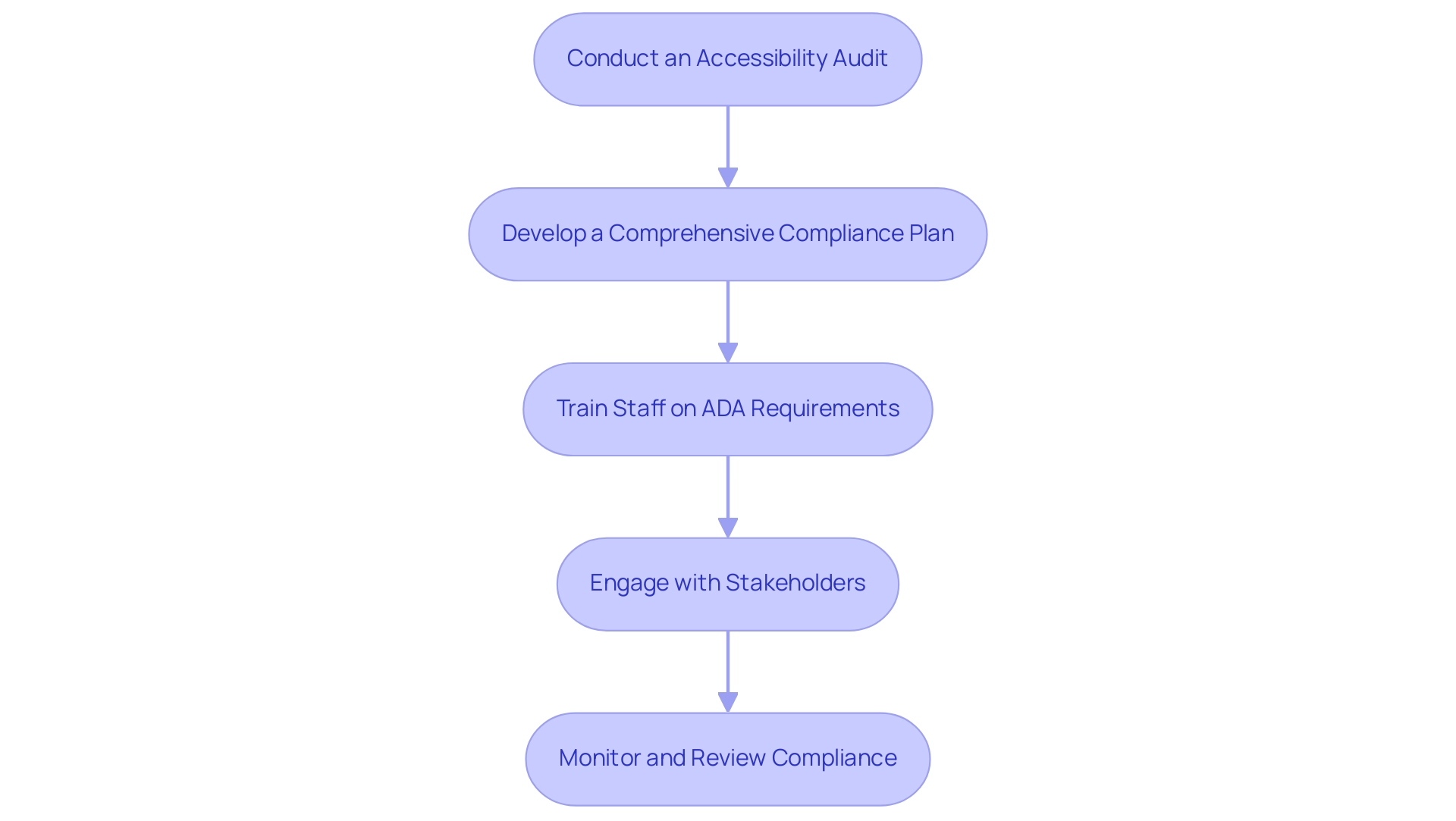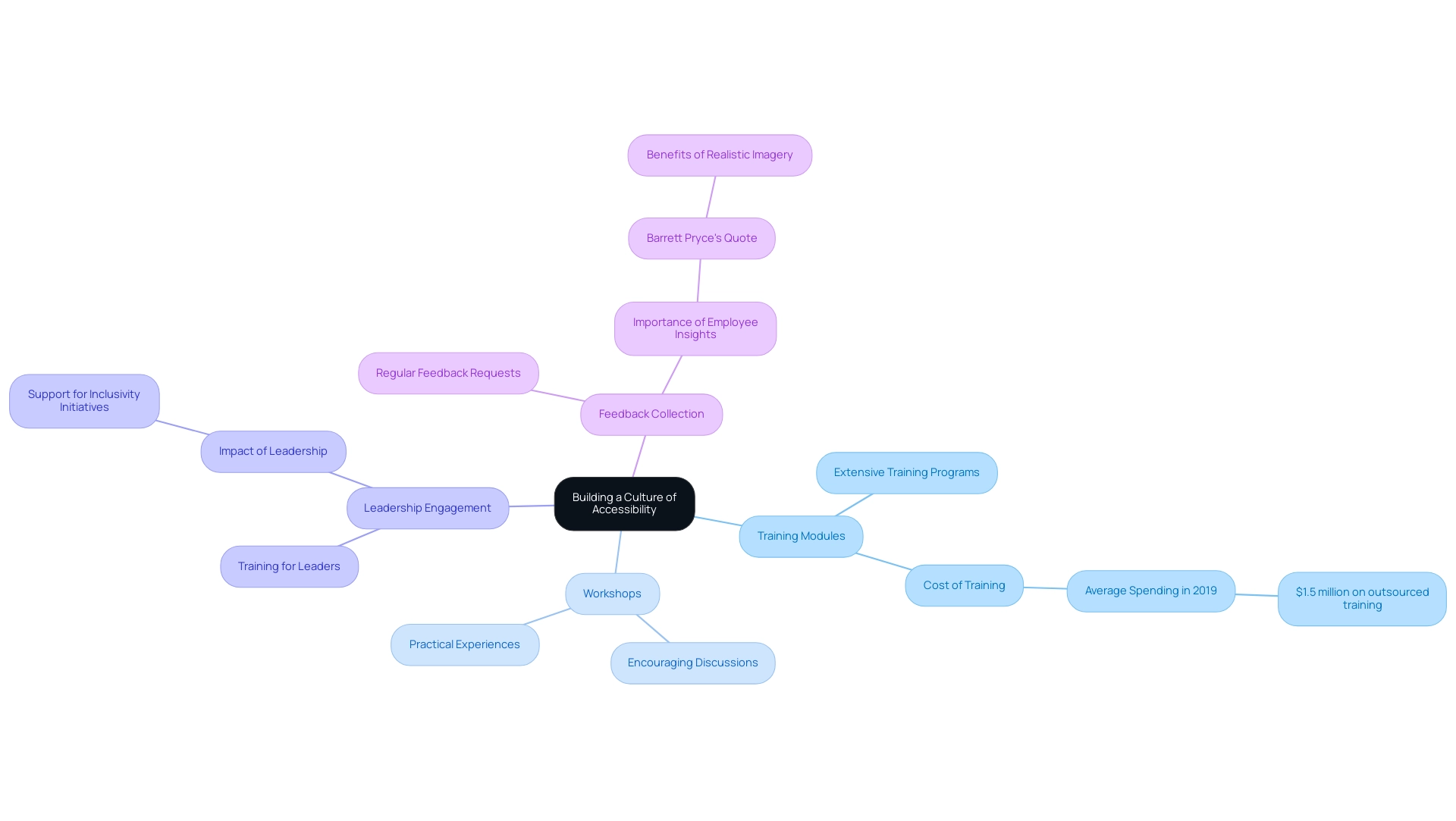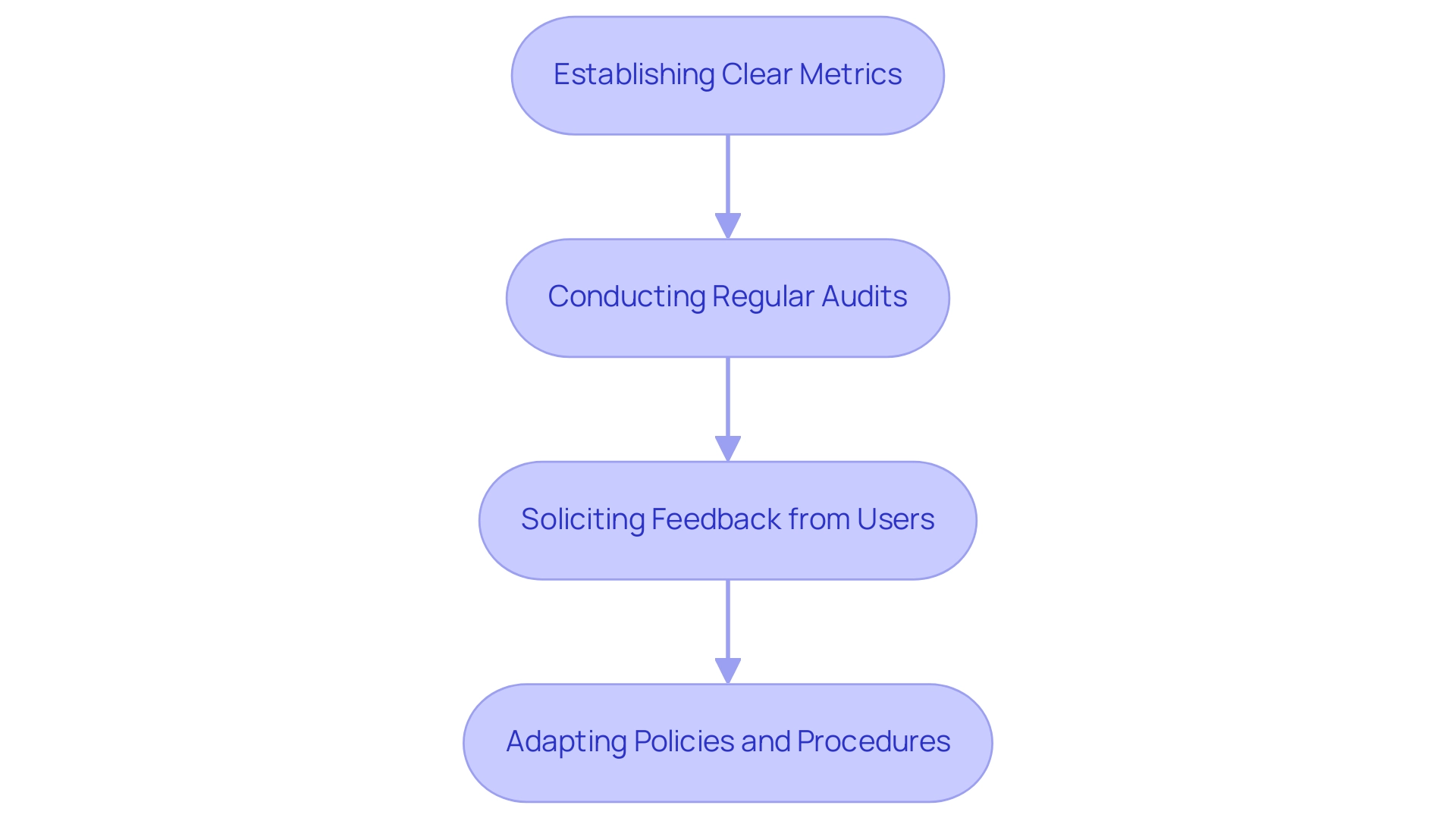Introduction
The 2025 ADA Standards mark a significant evolution in the quest for accessibility and inclusivity, introducing crucial changes that impact both physical and digital environments. These updates not only mandate wider doorways and accessible restrooms but also emphasize the importance of digital compliance, requiring organizations to ensure their online services are navigable for all users, including those with disabilities.
As businesses adapt to these standards, the need for comprehensive staff training and stakeholder engagement becomes paramount, fostering a culture that prioritizes inclusivity. Understanding these changes is essential for organizations aiming to comply with the new regulations and promote equitable access for everyone.
This article delves into the key updates, compliance strategies, and the critical role of ongoing evaluation in achieving lasting improvements in accessibility.
Overview of the 2025 ADA Standards: Key Changes and Implications
The ADA 2025 introduces several pivotal changes aimed at improving ease of access and inclusivity across various settings. These updates feature stricter requirements for physical spaces, including wider doorways and accessible restrooms, ensuring that individuals with disabilities can navigate environments more easily. Alongside physical adherence, there are significant digital accessibility requirements mandated for websites and online services, reflecting a growing recognition of the importance of virtual access in today’s society.
Organizations are now required to implement comprehensive training programs for staff, equipping them with the knowledge and skills necessary to assist individuals with disabilities effectively. Such initiatives not only aim to improve access—both physical and digital—but also underscore the necessity of cultivating a culture of inclusivity within all organizational frameworks. Grasping these implications is essential for guaranteeing adherence and actively fostering a more equitable environment for all individuals.
Furthermore, it is important to note that a live webinar on the ADA Standards of Care in Diabetes will be held on January 15, ADA 2025, from 1:00 p.m. to 2:30 p.m. EST, providing an opportunity for deeper insights into these standards. Additionally, according to Breakthrough T1D, if you have an immediate family member with Type 1 Diabetes, your chances of developing the condition are one in 20, which is 15 times higher than the general population. This statistic highlights the significance of understanding diabetes in the context of ADA standards.
The ADA also promotes a person-centered approach in diabetes care, as demonstrated in the case study titled ‘Improved Individualized Care,’ which emphasizes the importance of individualized care and the need for routine mental health checkups for those affected by diabetes.
Ensuring Compliance: Steps Organizations Must Take for ADA 2025
To attain adherence to the ADA 2025 Standards, organizations should implement the following steps:
- Conduct an Accessibility Audit: Assess current facilities and digital platforms to pinpoint areas requiring enhancement. This critical evaluation serves as the foundation for subsequent actions.
- Develop a Comprehensive Compliance Plan: Formulate a detailed plan that specifies the required modifications and establishes a timeline for their execution. This guarantees a systematic method to adherence while validating your product’s conformity throughout the process.
- Train Staff on ADA Requirements: Offer training sessions for all employees to ensure they are well-versed in the new standards and equipped to assist individuals with disabilities effectively. Training fosters a culture of awareness and responsiveness.
- Engage with Stakeholders: Actively involve individuals with disabilities in the planning process to gain valuable insights into their unique needs and preferences, thereby enhancing the effectiveness of adherence efforts.
- Monitor and Review Compliance: Regularly assess the effectiveness of the implemented changes, remaining vigilant to adapt to future updates or revisions to the ADA standards. Ongoing monitoring is crucial for sustained adherence. Significantly, 27% of security and IT experts consider alleviating internal audit fatigue as a primary regulatory challenge, emphasizing the necessity of a proactive strategy.
By adhering to these steps, entities can fulfill the requirements of ADA 2025 while fostering a more inclusive environment for all individuals. As Emily Bonnie, Senior Content Marketing Manager, observes, ‘Three out of five corporate risk and regulatory professionals feel confident about their ability to address regulatory risks.’ This confidence can be bolstered through diligent adherence to these steps.
Understanding Digital Compliance: Ensuring Accessible Online Services
Digital compliance under the ADA 2025 Standards requires that entities ensure their websites and online services are accessible to all users, including those with disabilities. This requirement is closely aligned with the Web Content Accessibility Guidelines (WCAG), which serve as a framework for creating inclusive digital environments. Key steps for organizations aiming to improve their digital inclusivity include:
- Performing a Website Audit: This initial step involves identifying barriers that may hinder users with disabilities from accessing content. A 2022 Gartner report noted that accessible websites improved user experience by 30%, underscoring the value of thorough audits.
- Implementing Accessible Design Practices: Utilizing proper HTML tags, providing alternative text for images, and ensuring navigability via keyboard are essential practices that enhance usability. Significantly, research shows that 48% of the most visited federal websites in the US do not meet basic standards for user access, emphasizing the necessity for enhanced design practices. Furthermore, a case study on the usability of forms revealed that 1 in 4 forms are missing descriptive labels for users with disabilities, and 81% of tested domains had at least one page with functionality issues related to forms. This emphasizes the importance of ensuring that forms are accessible, as many users encounter errors when submitting information, leading to frustration and potential abandonment of health-related services.
- Regularly Updating Content: It is vital to ensure that all new material complies with usability standards at the time of publication. This proactive approach prevents outdated practices from compromising user access. For Type 2 Diabetes patients, this means ensuring that health information and resources are readily accessible and usable.
- Providing Accessible Customer Support: Organizations should guarantee that customer service channels are accessible to all users, including those who may require additional assistance. Incorporating multimedia content with captions or transcriptions is vital for accommodating users with hearing impairments and those in noisy environments.
Prioritizing digital inclusion not only enhances organizational reach but also ensures compliance with ADA 2025 standards, as emphasized by experts in the field who advise, > Don’t be just another web inclusivity statistic <. By adopting these best practices, entities can foster a more inclusive online presence, ultimately benefiting both users, including those managing Type 2 Diabetes, and the entity.
Training and Education: Building a Culture of Accessibility
Creating a culture of inclusivity requires organizations to prioritize training and education in accordance with the ADA 2025. Key strategies for fostering such a culture include:
-
Creating Extensive Training Modules: Organizations should design training programs that cover the fundamentals of ADA regulations, addressing both physical and digital inclusivity requirements.
Notably, large companies spent an average of $1.5 million on outsourced training services in 2019, underscoring the financial commitment required for effective training programs.
-
Conducting Regular Workshops: Workshops should be arranged to encourage discussions and offer practical experiences with various assistive tools and technologies.
-
Engaging Leadership: It is essential for organizational leaders to receive training and demonstrate a commitment to promoting inclusivity, as their support plays a pivotal role in establishing a culture of compliance. As mentioned by industry leaders, their active participation can significantly affect the success of inclusive initiatives.
-
Collecting Feedback: Regularly requesting feedback from employees regarding the training programs enables companies to make necessary adjustments based on insights gathered. As Barrett Pryce noted,
People who have learning disabilities and difficulty focusing for long periods of time will benefit from realistic, current imagery.
Additionally, emerging technologies such as VR, AR, and AI, as highlighted in the case study titled “Technological Advancement and Personalized Corporate Learning,” can enhance the personalization and effectiveness of training programs. By highlighting education, entities can enable their workforce to support and execute inclusion initiatives effectively.
Monitoring and Evaluation: Ensuring Continuous Improvement
To achieve and maintain compliance with the ada 2025 Standards, entities must implement a systematic monitoring and evaluation process. Statistics indicate that organizations prioritizing inclusivity can enhance their reputation and improve user experience, leading to increased traffic and customer loyalty. The following steps are essential:
- Establishing Clear Metrics: Organizations should define explicit metrics that assess both physical and digital usability, ensuring a comprehensive evaluation framework.
- Conducting Regular Audits: Implementing a schedule for periodic audits will assist in evaluating current adherence levels and identifying specific areas that require improvement.
- Soliciting Feedback from Users: Actively gathering input from individuals with disabilities is crucial for understanding their experiences with current facilitation measures. This feedback serves as a cornerstone for meaningful enhancements.
- Adapting Policies and Procedures: Organizations should be prepared to revise their internal policies based on audit results and user feedback, thereby fostering a responsive and inclusive environment.
As Hanna Salo, Senior Manager of the E-Commerce Business Unit at Lenovo, stated, ‘I have to say that the EqualWeb team has been one of the best partners for Lenovo.’
Embracing these practices ensures that organizations not only meet compliance standards but also commit to ongoing improvements in accessibility as outlined by ada 2025, ultimately benefiting a wider audience.
Conclusion
The 2025 ADA Standards represent a crucial advancement in ensuring accessibility and inclusivity across both physical and digital landscapes. Key changes include stricter requirements for physical spaces, such as:
- Wider doorways
- Accessible restrooms
Alongside significant digital compliance mandates that require organizations to make their online platforms navigable for users with disabilities. By implementing comprehensive training for staff and engaging stakeholders in the process, organizations can foster a culture of inclusivity that is essential for compliance and equitable access.
To successfully meet these standards, organizations must:
- Conduct thorough accessibility audits
- Develop detailed compliance plans
- Continuously monitor their efforts
The emphasis on digital compliance highlights the importance of creating accessible websites that adhere to established guidelines. Regular updates and accessible customer support are vital to ensure that all users, including those managing health conditions such as Type 2 Diabetes, can access the services they need without barriers.
Ultimately, establishing a culture of accessibility through ongoing education and evaluation is not merely a regulatory requirement; it enhances organizational reputation and user experience. By prioritizing these practices, organizations can not only comply with the new ADA standards but also make meaningful strides toward inclusivity, benefiting both individuals with disabilities and the wider community. Embracing these changes is essential for creating a more equitable environment for all.
Frequently Asked Questions
What are the main changes introduced by the ADA 2025?
The ADA 2025 introduces stricter requirements for physical spaces, such as wider doorways and accessible restrooms, as well as significant digital accessibility requirements for websites and online services to improve access for individuals with disabilities.
What training is required for organizations under the ADA 2025?
Organizations are required to implement comprehensive training programs for staff to equip them with the knowledge and skills necessary to assist individuals with disabilities effectively.
Why is it important for organizations to cultivate a culture of inclusivity?
Cultivating a culture of inclusivity is essential for ensuring adherence to ADA standards and fostering a more equitable environment for all individuals.
When is the live webinar on the ADA Standards of Care in Diabetes scheduled?
The live webinar on the ADA Standards of Care in Diabetes will be held on January 15, ADA 2025, from 1:00 p.m. to 2:30 p.m. EST.
What is the significance of the statistic regarding Type 1 Diabetes and family history?
If an individual has an immediate family member with Type 1 Diabetes, their chances of developing the condition are one in 20, which is 15 times higher than the general population, highlighting the importance of understanding diabetes in the context of ADA standards.
What is the person-centered approach promoted by the ADA?
The ADA promotes a person-centered approach in diabetes care, emphasizing individualized care and the need for routine mental health checkups for those affected by diabetes.
What are the steps organizations should take to attain adherence to the ADA 2025 Standards?
Organizations should conduct an accessibility audit, develop a compliance plan, train staff on ADA requirements, engage with stakeholders, and monitor and review compliance regularly.
Why is it important to engage individuals with disabilities in the planning process?
Engaging individuals with disabilities provides valuable insights into their unique needs and preferences, enhancing the effectiveness of adherence efforts.
What challenges do organizations face regarding compliance monitoring?
A significant challenge is alleviating internal audit fatigue, as noted by 27% of security and IT experts, emphasizing the need for a proactive strategy in compliance monitoring.
How can organizations build confidence in addressing regulatory risks?
Organizations can bolster their confidence in addressing regulatory risks by diligently adhering to the steps outlined for compliance with ADA 2025.


